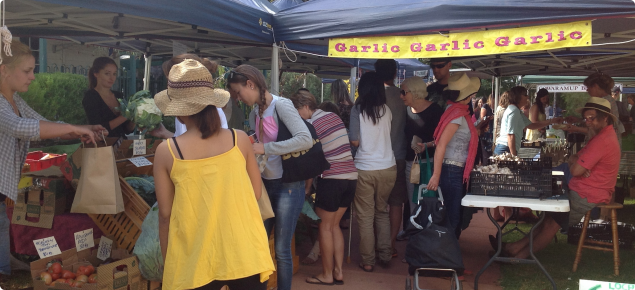Direct selling channels can include co-operatives, farmers' markets, community supported agriculture (CSA), agritourism, pick-your-own enterprises, roadside stalls, direct sales to restaurants, internet sales or delivery services.
Direct selling strategies can vary immensely. The right channel(s) will depend on the wants, needs and characteristics of your market. It is useful to research your market and try a number of different channels to determine the most suitable approach.
Using multiple selling channels can reduce risk and may increase earnings.
Purchasing locally produced food continues to increase ensuring that direct selling remains a relevant strategy.
Farmers' Markets
A farmers' market is a gathering of several producers on a regular basis to sell a variety of locally produced fruits, vegetables and other value-added farm products directly to consumers.
Farmers' markets are commonly held on weekends throughout the metropolitan area and in many regional towns, which may require travel.
Markets provide a suitable environment for farmers and food producers to sell direct to customers products of farm-origin and associated value-added or processed artisan food.
Be it organic, bio-dynamic or conventional production systems, the fresh produce available at farmers’ markets can attract a loyal and enthusiastic following.
A regular stall at a farmers' market requires very little capital investment. You will require a table, shelter, packaging and signage to identify your business name, products and their price.
Costs may include stall fees, equipment, packaging, public liability insurance, sales labour, transportation and storage.
Advertising costs are commonly low as it is often done en-masse by the farmers' market management team where you are participating and is usually included in your stall fees.
Successful markets:
- are located in busy or central areas
- are supported by genuine integrity (e.g. sell only locally produced food)
- have an effective market manager to promote the market and reinforce the rules
- have a good number of stalls and a good mix of products.
Co-operatives
Co-operatives are organisations owned and operated by a group of people with similar needs.
In Western Australia, a co-operative must be created by a minimum of five individuals, incorporated associations or companies.
A co-operative may be established by a group of people producing the same products as a way to market their products together at an overall lower price. It may also mean that with increased volume, co-operatives can enter markets that they were unable to penetrate on their own.
A co-operative may also pack, store and ship a product.
A co-operative can give producers more power to:
- promote and sell the product
- negotiate the price they receive and better market terms
- reduce the costs of marketing and obtaining inputs
- ensure continuity of supply
- secure a market.
Co-operatives are more likely to succeed when all members have shared expectations.
Community supported agriculture
Community supported agriculture (CSA) offers consumers ‘shares’ in a farm. By becoming a ‘shareholder’, the consumer takes on the risk of farming along with the farmer and in exchange receives produce on a regular basis throughout the growing season.
For instance ‘shareholders’ pay for their ‘shares’ at the beginning of the season. If the season goes well then the ‘shareholder’ will receive their produce at each designated time period (e.g. each week).
If there is an event during the season that compromises production the shareholder will receive a reduced amount of produce or if the crop is wiped out, no produce at all. Hence the risk of farming is shared throughout the season by both the farmer and the shareholder.
This can be similar to a 'rent a row' or 'tree' operation where a customer buys a row or tree at the beginning of the season.
The farmer then provides all the necessary labour and inputs and the customer harvests the product at the end of the season and takes the produce home.
A CSA can be easier to plan for and is an important risk management strategy as your product is sold before the growing season commences.
CSA’s can be made up of a number of farms, each producing a few different crops, to provide shareholders with more variety and spread the workload involved across a larger number of farms.
Farmers will need to consider the amount of time needed to be spent with members, delivery time, the need for detailed production records and the variety of crops required when deciding whether to undertake such an enterprise.
A written contract should be drawn-up that states that the quality and quantity risks are assumed by the shareholder.
Most shareholders like to visit the farm throughout the year, so offering events during the growing season can give shareholders the opportunity to come out to the property.
Always consider whether allowing public access will cause any concerns, such as biosecurity issues.
CSA’s work best when located close to urban areas. This gives the farm access to a greater consumer base, allows consumers to visit or attend meetings and results in lower delivery costs.
The shared agricultural risk advantages from CSA's may sometimes be offset when products destined for members are unable to be offered through other sales channels where greated financial returns may have been achieved.


